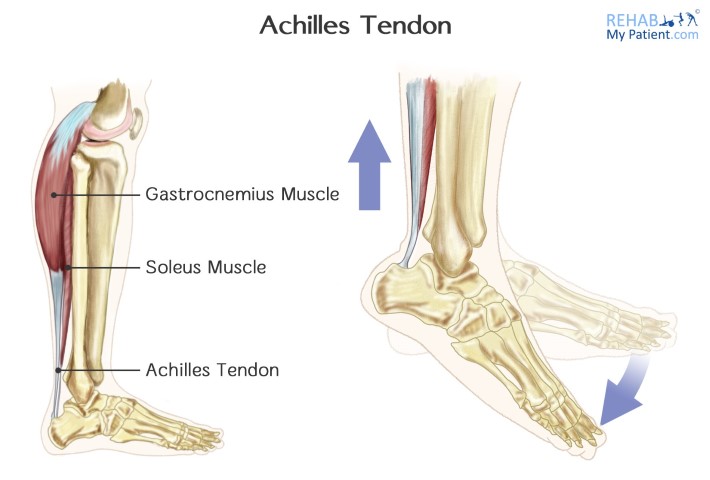
What is the Achilles tendon?
The Achilles tendon is an important structure in the back of the leg above the heel bone (known as the calcaneus). It connects the heel bone with the calf muscles. The Achilles tendon helps the bending forward movement of the foot (plantar flexion).

What is Achilles tendinopathy?
Achilles tendinopathy (often called Achilles tendonitis) is a musculoskeletal complaint that presents with signs and symptoms such as: pain, swelling, stiffness and weakness. The pain is usually located at the back just above the heel. Typically the pain can be fine when walking, but aggravated when running or exercising. The cause of Achilles tendinopathy is repetitive strain, which is commonly referred as microtrauma. Incomplete healing after each injury leads to build up of damage in the tendon and subsequently Achilles tendinopathy develops.
Achilles tendinopathy can be very chronic, difficult to shift, and debilitating. The main problem is the constant force going through the Achilles, and the poor blood supply to the Achilles making healing slower. Another problem is that when the patient feels pain in their Achilles, often the problem has been underlying for several months previously before the body is alerted by the pain, so although you may have had “pain” in the Achilles for a few days, it may have been present far longer. Do not be surprised if it takes 6-9 months for complete recovery, although with treatment this time period is often far shorter.
What causes Achilles tendinopathy?
- Excessive use of the tendon: usually in runners, dancers or other activities that involve jumping.
- Inappropriate footwear/training/exercising techniques.
- Increasing intensity and frequency of training.
- Training on hard surfaces.
- High arch in the foot (pes cavus).
- Lack of flexibility (especially tight calf muscles).
- A change in gait.
Non-surgical treatment
- Painkillers or anti-inflammatories (paracetamol/ibuprofen).
- Ice (use for up to ten minutes, five times per day, or as your therapist advises). Be careful of ice burns; always use a towel.
- Achilles tendon exercises: focused on stretching and strengthening of the tendon to improve mobility and decrease pain. Your therapist is able to help you with an exercise program that suits your needs. Treatment may also include ultrasound and massage in order to stimulate healing. Mobility of the foot can also help reduce force going into the tendon, and reducing muscle tension in the calf and other lower leg muscles can be beneficial.
- Orthotics (shoe insoles) may help decrease pain. It is best to have bespoke orthotics, i.e. they are measured specifically for your feet. Usually this involves walking on a gait plate, or pressure plate, and measurements are taken of your foot position during the gait cycle and an orthotic is made accordingly.
- Heel lift – a small heel lift can raise the calcaneus (heel bone) and take tension out of the Achilles and calf muscles.
Acupuncture for Achilles Pain
Acupuncture is often not the first choice of treatment, as it can be tender around the Achilles tendon. However, when acupuncture is used it can be effective at reducing inflammation to the tendon. Thin needles are put in and around the tendon just a few millimeters deep. There are no common side-effects to acupuncture and some patients can get considerable relief from the treatment.
High volume injection
Chronic Achilles pain that is not responding to conservative methods of treatment may respond to a high volume saline injection. The injection may be used with a small anesthetic and steroid as well, and the purpose is to distend the space between the tendon and the sheath.
Surgical treatment
Surgery is used to remove nodules or adhesions from the injured tendon. Another approach is cutting the tendon lengthways aiming at reinforced tendon healing. Complications of the surgery include rupture of the tendon or wound healing implications. Tendon stripping can also be used, where a small incision is made in the tendon, and adhesions between the tendon and the tendon sheath are cut allowing mobility of the Achilles.
Sign Up
Sign up for your free trial now!
Get started with Rehab My Patient today and revolutionize your exercise prescription process for effective rehabilitation.
Start Your 14-Day Free Trial